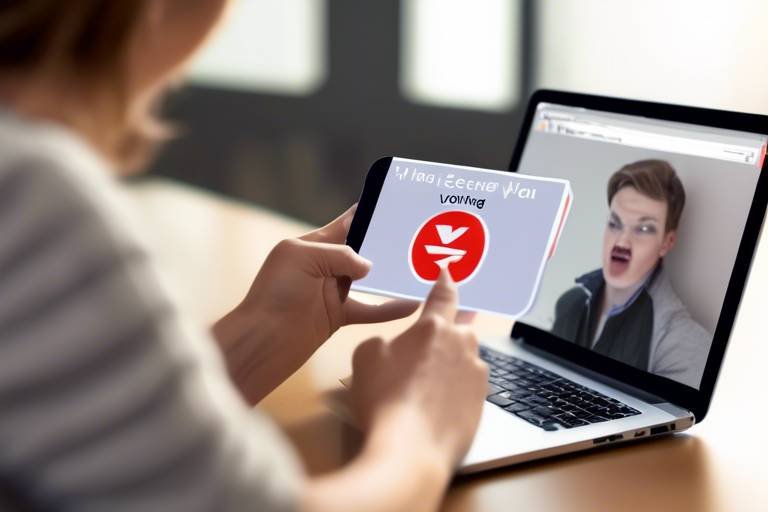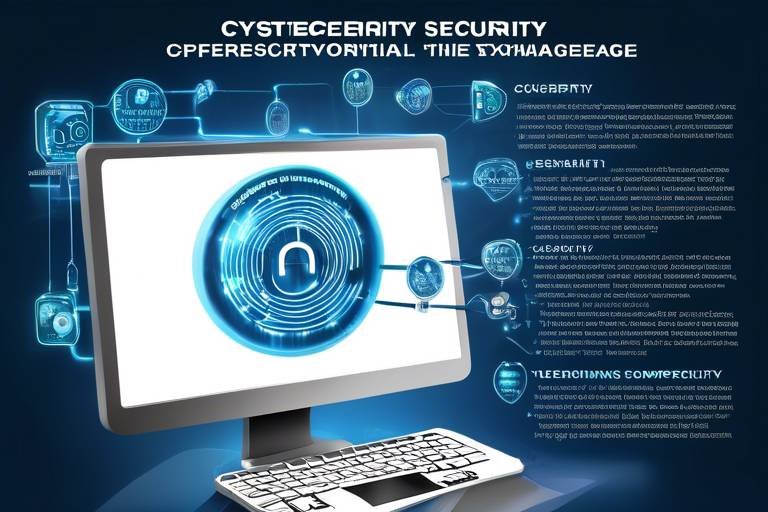Cybersecurity and the Importance of Secure Passwords
In today's digital age, where our lives are intertwined with technology, the significance of secure passwords cannot be overstated. Think of passwords as the keys to your digital kingdom; without them, anyone can waltz right in and wreak havoc on your personal or organizational data. Cybersecurity is like a fortress, and passwords are the gates that keep intruders at bay. But how strong are those gates? This article dives deep into the critical role that secure passwords play in the broader landscape of cybersecurity, exploring best practices, common pitfalls, and the ever-evolving strategies to protect our sensitive information.
Passwords are your first line of defense against cyber threats. Imagine trying to enter a highly secure building without a key; that’s what it’s like for a hacker trying to access your data when you have strong passwords in place. They act as barriers, protecting your personal information, financial records, and confidential business data from unauthorized access. Understanding the importance of these digital keys is essential for everyone, from everyday users to large organizations. A weak password is like leaving your front door wide open, inviting trouble. In a world where data breaches make headlines almost daily, securing your passwords is not just a good practice; it’s a necessity.
A strong password is your best defense against unauthorized access. But what exactly makes a password robust? There are several key features to consider:
- Length: Longer passwords are generally more secure. Aim for at least 12 characters.
- Complexity: Use a mix of uppercase letters, lowercase letters, numbers, and special characters.
- Unpredictability: Avoid common words or phrases that can be easily guessed.
When it comes to password security, length and complexity go hand in hand. The longer your password, the harder it is for hackers to guess. Think of it as building a tall wall versus a short fence. A strong password should ideally be at least 12 characters long and include a variety of characters. Complexity adds another layer of security; using symbols and numbers can significantly enhance your password's strength. For example, instead of using “password123,” opt for something like “P@ssw0rd!2023.” This simple change can make a world of difference in your cybersecurity.
Have you ever struggled to remember a complex password? Enter the concept of passphrases. These are combinations of random words that create a memorable yet secure password. For instance, “BlueElephantDances@Midnight” is not only easy to remember but also incredibly difficult for anyone else to guess. Passphrases can be a game-changer in password security, as they allow you to create longer, more complex passwords without the burden of memorization. Just remember to avoid using common phrases or quotes that could be easily guessed!
Many users fall into predictable patterns when creating passwords, which can be a hacker's dream. Common mistakes include using easily guessed information like birthdays, names, or simple sequences like “123456.” To enhance your security, consider these tips:
- Avoid using the same password across multiple accounts.
- Don’t use easily accessible information.
- Change passwords regularly.
Think of your passwords like milk; they have an expiration date. Regularly updating your passwords is crucial for maintaining security. But how often should you change them? Experts recommend updating your passwords at least every three to six months. This practice not only helps mitigate the risks associated with potential data breaches but also keeps your accounts secure from ongoing threats. Remember, a password is only as strong as its last update!
While strong passwords are essential, they are just one part of the security puzzle. Multi-factor authentication (MFA) adds an extra layer of protection by requiring additional verification methods beyond just a password. This could be something you have (like a smartphone) or something you are (like a fingerprint). By implementing MFA, you significantly decrease the chances of unauthorized access, even if your password is compromised.
There are various forms of MFA, including:
- SMS Codes: A one-time code sent to your phone.
- Authenticator Apps: Apps like Google Authenticator generate time-sensitive codes.
- Biometric Verification: Using fingerprints or facial recognition for authentication.
Enabling multi-factor authentication is a straightforward process. Most platforms offer simple steps to activate MFA in your account settings. By taking this extra step, you significantly enhance your overall cybersecurity posture, making it much harder for cybercriminals to gain access to your sensitive information.
Managing multiple passwords can be a daunting task, but password managers can simplify this process while ensuring security. They securely store and encrypt your passwords, allowing you to use unique, complex passwords for all your accounts without the hassle of memorization. Think of a password manager as your digital vault, keeping your keys safe and sound.
Not all password managers are created equal. When selecting one, consider features such as:
- Encryption methods used to protect your data.
- User-friendly interface for easy access.
- Cross-platform compatibility.
Using a password manager effectively involves following certain best practices. Always ensure that your master password is strong and unique, as it is the key to accessing your vault. Enable two-factor authentication for your password manager for added security. Regularly review and update passwords stored in your manager to maintain a high level of security.
Q: How often should I change my passwords?
A: It's recommended to change your passwords every three to six months, or immediately if you suspect a breach.
Q: What makes a password strong?
A: A strong password is at least 12 characters long, includes a mix of letters, numbers, and symbols, and avoids easily guessed information.
Q: Is multi-factor authentication necessary?
A: Yes! MFA adds an essential layer of security beyond just passwords, making it significantly harder for unauthorized users to access your accounts.
Q: Can I use the same password for multiple accounts?
A: No, using the same password across multiple accounts increases your risk. If one account is compromised, others become vulnerable too.

The Role of Passwords in Cybersecurity
Passwords are like the keys to your digital kingdom. Imagine your online accounts as fortified castles, and passwords as the gates that protect them. Without a strong gate, anyone can waltz in and wreak havoc. In today's interconnected world, where data breaches and cyber threats are rampant, understanding the role of passwords in cybersecurity is more important than ever. They serve as the first line of defense, safeguarding sensitive information, from personal emails to corporate secrets. But how effective can a password really be?
To illustrate, let's consider a scenario: You walk into a bank, and instead of checking your ID, the teller just asks for your name. Sounds absurd, right? Yet, that's akin to how many people treat their online accounts—relying on weak or easily guessable passwords. Cybercriminals are constantly on the prowl, using sophisticated techniques to crack passwords and gain unauthorized access. This is why a robust password strategy is essential.
Moreover, the importance of strong passwords extends beyond individual users. Organizations are also at risk, with data breaches costing billions of dollars annually. According to recent studies, a staggering 80% of data breaches are linked to weak or stolen passwords. This statistic underscores the necessity for both individuals and businesses to prioritize password security. But what makes a password truly secure? Let's delve into the characteristics that define a strong password.
In the digital landscape, passwords must be treated with the same level of care as physical keys. Here are some crucial aspects to consider:
- Length: A longer password is typically more secure.
- Complexity: Incorporating symbols, numbers, and uppercase letters enhances security.
- Unpredictability: Avoiding common phrases or easily guessable information is vital.
In conclusion, passwords are not just a mere inconvenience; they are a critical component of cybersecurity. By treating them with the seriousness they deserve, you can significantly reduce your risk of falling victim to cyber threats. Always remember, in the realm of cybersecurity, your password is your first line of defense—so make it count!

Characteristics of a Strong Password
When it comes to online security, a strong password is your first line of defense against cyber threats. But what exactly makes a password strong? Understanding the key characteristics is essential for creating passwords that can withstand the test of time and the prying eyes of hackers. A robust password is not just a random collection of letters and numbers; it embodies several crucial elements that work together to enhance security.
First and foremost, length is a critical factor. Studies have shown that longer passwords are significantly harder for attackers to crack. A password with at least 12 to 16 characters is generally recommended. However, length alone isn’t enough. Complexity plays a vital role as well. A strong password should include a mix of uppercase and lowercase letters, numbers, and special characters. This combination creates a much more challenging puzzle for anyone attempting unauthorized access.
Moreover, unpredictability is another essential characteristic. Passwords that are based on easily accessible information, such as birthdays or pet names, are far too predictable. Instead, consider using a combination of unrelated words or phrases. For example, instead of using “Fluffy123,” try something like “BlueSky!Pizza&Rain.” This method not only makes your password harder to guess but also makes it easier to remember.
One effective way to create a strong password is by using passphrases. A passphrase is a sequence of words or a sentence that is easy for you to remember but hard for others to guess. For instance, “MyDogLovesToBark@Night!” is a strong passphrase that combines length, complexity, and unpredictability. The beauty of a passphrase is that it can be both memorable and secure, allowing you to avoid the frustration of forgetting your password.
While creating strong passwords, it’s crucial to avoid common pitfalls. Many users tend to fall into predictable patterns, such as using the same password across multiple sites or opting for simple substitutions (like “P@ssw0rd” instead of “Password”). These practices can severely compromise your security. To enhance your password strength, aim to:
- Use unique passwords for different accounts.
- Avoid using easily guessed information.
- Regularly update your passwords to keep them fresh.
By steering clear of these pitfalls and focusing on length, complexity, and unpredictability, you can create passwords that serve as an effective barrier against cyber threats. Remember, your password is like a key to your digital life; the stronger it is, the safer you are.

Length and Complexity
When it comes to creating a secure password, are your best friends. Think of your password as a fortress; the longer and more intricate the walls, the harder it is for intruders to breach. A password that is at least 12 to 16 characters long is generally considered strong. This length allows for a greater combination of characters, which significantly increases the difficulty for hackers attempting to crack it using brute force methods.
But length alone isn't enough! Complexity plays a crucial role too. A password that consists solely of a sequence of letters, like "abcdefgh," is far too predictable. Instead, aim to incorporate a mix of uppercase letters, lowercase letters, numbers, and special characters (like @, #, $, etc.). For example, a password like "Giraffe#42Dance!" is not only longer but also much harder to guess. Here's how you can think about it:
| Feature | Weak Example | Strong Example |
|---|---|---|
| Length | abc123 | Giraffe#42Dance! |
| Complexity | password |
Moreover, using a combination of unrelated words can also enhance complexity. This technique is often called a passphrase. For example, "BlueSky!Pineapple@Dance" is both lengthy and complex, making it a formidable barrier against potential attacks. The beauty of passphrases lies in their memorability; they can be easier to remember than a random string of characters while still being incredibly secure.
In the end, the key takeaway is simple: the longer and more complex your password, the better your chances of keeping your information safe. So, next time you create a password, remember to think of it as a shield protecting your digital life!

Using Passphrases
In the realm of cybersecurity, where threats loom large and data breaches are all too common, can be a game changer. Unlike traditional passwords, which often consist of a jumble of letters, numbers, and symbols, passphrases are typically longer and made up of a sequence of words or a sentence. This makes them not only easier to remember but also significantly more difficult for cybercriminals to crack. Imagine trying to break into a vault protected by a long, whimsical phrase rather than a short, complex code; the former is like trying to solve a riddle, while the latter is akin to guessing a four-digit PIN.
To effectively create a passphrase, consider the following tips:
- Length is Key: Aim for a passphrase that is at least 12-16 characters long. The longer, the better!
- Use Random Words: Combine unrelated words to form a unique phrase. For example, “BlueElephantDances@Midnight” is both memorable and secure.
- Add Complexity: Incorporate numbers and symbols to increase security. For instance, “Happy4Cats!Jump” adds an extra layer of difficulty for potential hackers.
What’s fascinating about passphrases is their potential for creativity. You can think of them as a personal mantra or a line from your favorite song. This personalization not only makes them memorable but also adds an emotional connection, making it less likely that you'll forget them. However, it’s crucial to ensure that your passphrase is not something easily guessable, like a favorite quote from a well-known movie or a common phrase.
Another advantage of using passphrases is their adaptability. You can modify them slightly for different accounts while still maintaining a core structure. For example, if your main passphrase is “SunnyDaysAreBest!”, you could alter it to “SunnyDaysAreBest!2023” for your bank account. This way, you keep the essence of your passphrase while ensuring each one is unique, which is a critical aspect of password security.
In conclusion, adopting passphrases as a security measure not only strengthens your defenses against cyber threats but also simplifies the often cumbersome task of remembering multiple passwords. By creating long, complex, and personalized passphrases, you can significantly enhance your cybersecurity posture without sacrificing convenience. So, why not give it a try? Your digital life will thank you!
Q: What is a passphrase?
A passphrase is a sequence of words or a sentence used as a password, designed to be longer and more secure than traditional passwords.
Q: How do I create a strong passphrase?
Combine random words, use a mix of uppercase and lowercase letters, and include numbers and symbols to enhance security.
Q: Are passphrases easier to remember than passwords?
Yes, because they can be based on phrases or sentences that are personally meaningful, making them easier to recall.
Q: Can I use the same passphrase for multiple accounts?
While it’s possible, it’s not recommended. Try to modify your passphrase slightly for different accounts to enhance security.

Avoiding Common Pitfalls
When it comes to creating passwords, many users unwittingly fall into predictable patterns that can compromise their security. It's almost like wearing a flashy sign that says, "Come hack me!" So, how can we steer clear of these common pitfalls? First, let’s address the tendency to use easily guessable information. Think about it: using your pet's name, your birthday, or even the word "password" itself is akin to leaving the front door wide open. Cybercriminals often employ sophisticated techniques to crack these weak passwords, so it’s essential to be more creative.
Another common mistake is the over-reliance on a single password across multiple accounts. Imagine if a thief stole your house keys. With just one set, they could access your home, your car, and even your office! Similarly, if a hacker gets hold of your password, they could infiltrate all your accounts in one fell swoop. To combat this, consider using unique passwords for each account. Yes, it may seem like a hassle, but the peace of mind it brings is worth the effort.
Moreover, many people underestimate the importance of password length. A short password, no matter how complex, is still vulnerable. Aim for at least 12-16 characters, incorporating a mix of uppercase and lowercase letters, numbers, and special symbols. For example, instead of “P@ssw0rd”, consider using something like “$tr0ngP@ssw0rd123!”. The longer and more complex, the better!
Additionally, it's crucial to avoid using common keyboard patterns like "qwerty" or "123456." These are among the first combinations a hacker will try. You might as well put a neon sign over your keyboard saying, "Please hack me!" Instead, think outside the box. Consider using passphrases made up of random words that are easy for you to remember but hard for others to guess. For instance, “BlueSky!DancingElephant42” is both memorable and secure.
Lastly, don’t forget to regularly update your passwords. It’s like changing the locks on your doors every few months. You wouldn’t want to leave your home vulnerable, would you? Set a reminder every three to six months to change your passwords, especially for sensitive accounts. This simple act can significantly enhance your security and keep cyber threats at bay.
By avoiding these common pitfalls, you can significantly improve your password security and protect your valuable information. Remember, a little extra effort in crafting your passwords can save you from a world of trouble down the line. So, be smart, be safe, and always think twice before hitting that "Create Password" button!
- What makes a password strong? A strong password typically includes at least 12 characters, a mix of uppercase and lowercase letters, numbers, and special symbols.
- How often should I change my passwords? It's recommended to change your passwords every three to six months, especially for sensitive accounts.
- Should I use the same password for multiple accounts? No, using unique passwords for each account is crucial for maintaining security.
- What is a password manager? A password manager is a tool that securely stores and manages your passwords, making it easier to use unique passwords for different accounts.

Regular Password Updates
In the fast-paced digital world we live in today, are not just a good idea; they are a necessity. Imagine your password as a key to your house. Would you use the same key for years without changing it? Probably not! Just like you would change your locks if you lost your keys or if someone had access to them, updating your passwords regularly is crucial for maintaining your online security. Cyber threats are constantly evolving, and so should your defenses.
So, how often should you change your passwords? While there’s no one-size-fits-all answer, a good rule of thumb is to update your passwords every 3 to 6 months. This timeframe allows you to stay ahead of potential breaches without becoming overwhelmed by constant changes. However, if you suspect that your account has been compromised or if there has been a data breach involving a service you use, it’s essential to change your password immediately—like slamming the door shut when you hear someone trying to break in!
It's also important to note that different accounts may require different frequencies for updates. For example, sensitive accounts, such as banking or email, should be updated more frequently than social media accounts. Keeping track of these updates can be a hassle, which is why many people turn to password managers. These tools not only help you generate strong passwords but can also remind you when it's time to change them, ensuring that you’re always a step ahead of cybercriminals.
Now, let’s talk about some common misconceptions regarding password updates. Many people believe that constantly changing their passwords will lead to weaker security because they might resort to simpler, easier-to-remember passwords. This is a valid concern! To combat this, consider using passphrases or a password manager that can generate complex passwords for you. This way, you can maintain both security and ease of use.
In conclusion, regular password updates are a fundamental aspect of a robust cybersecurity strategy. By treating your passwords with the same care you would a physical key, you can significantly reduce your risk of falling victim to cyber threats. Remember, a little vigilance goes a long way in keeping your digital life secure!
- How often should I update my passwords? It’s recommended to change them every 3 to 6 months, or immediately if you suspect a breach.
- What should I do if I forget my password? Use the password recovery options provided by the service, and consider using a password manager in the future to avoid this issue.
- Are password managers safe? Yes, most reputable password managers use strong encryption and are considered safe for storing your passwords.

Multi-Factor Authentication
In today's digital age, relying solely on passwords for security is like locking your front door but leaving the windows wide open. Multi-Factor Authentication (MFA) is a crucial step in reinforcing that lock, providing an extra layer of security that is increasingly necessary to protect sensitive information. MFA requires not just a password but also a second form of verification, making it significantly harder for cybercriminals to gain unauthorized access to your accounts. Imagine trying to break into a vault that requires both a key and a secret code; this is the essence of MFA.
MFA is not just a buzzword; it's a necessity in our interconnected world where data breaches have become alarmingly common. By implementing MFA, you are essentially creating a barrier that requires more than just a stolen password to breach your accounts. This added security can come in various forms, which we will explore shortly. But first, let’s understand why MFA is so important. Cyber threats are evolving, and so should our defenses. With MFA, even if a password is compromised, the attacker still faces another hurdle. This dual-layer approach significantly reduces the risk of unauthorized access.
Now, let’s dive into how MFA works. Typically, when you log into an account, you’ll enter your password as usual. After that, you'll be prompted for a second factor, which could be:
- A code sent to your mobile device via SMS or email
- A time-sensitive code generated by an authenticator app
- Biometric verification, such as a fingerprint or facial recognition
Each of these methods adds a unique twist to the authentication process, making it much more difficult for hackers to succeed. For instance, even if someone manages to steal your password, they would still need access to your mobile device or biometric data to get in. This is why MFA is often touted as one of the best practices for securing online accounts.
Implementing MFA is not as complicated as it may sound. Most online services today offer MFA options in their security settings. By taking just a few minutes to enable this feature, you can significantly bolster your account's security. It's an investment of time that pays off in peace of mind. Remember, the goal is to make it as challenging as possible for anyone to breach your defenses.
In summary, Multi-Factor Authentication is an essential tool in the fight against cyber threats. By requiring more than just a password, MFA dramatically increases your security posture. It’s like having a personal bodyguard for your digital identity, ensuring that even if one door is breached, another remains locked tight. So, don’t wait for a cyber incident to happen; take action now and secure your accounts with MFA!
What is Multi-Factor Authentication?
MFA is a security measure that requires two or more verification methods to gain access to an account, enhancing protection beyond just a password.
Why should I use Multi-Factor Authentication?
Using MFA significantly reduces the risk of unauthorized access to your accounts, even if your password is compromised.
What are the common methods of Multi-Factor Authentication?
Common methods include SMS codes, authenticator apps, and biometric verification like fingerprints or facial recognition.
How do I enable Multi-Factor Authentication on my accounts?
You can enable MFA by going to the security settings of your online services and following the prompts to set it up.

Types of Multi-Factor Authentication
When it comes to protecting your online accounts, multi-factor authentication (MFA) is like adding a deadbolt to your front door—it's an extra layer of security that can make a world of difference. But what exactly are the different types of MFA available, and how do they work? Let's dive into the various forms of MFA, so you can choose the right one for your needs.
At its core, MFA requires users to provide two or more verification factors to gain access to an account. This means that even if someone manages to steal your password, they still won’t be able to access your account without the additional factors. Here are some of the most common types of MFA:
- SMS Codes: This method sends a one-time code to your mobile device via SMS. While it's convenient, be cautious—SMS can be intercepted, making this method less secure than others.
- Authenticator Apps: Applications like Google Authenticator or Authy generate time-based codes that refresh every 30 seconds. These apps are more secure than SMS because they don’t rely on your phone network.
- Biometric Verification: This cutting-edge method uses unique biological traits like fingerprints, facial recognition, or even retina scans to verify your identity. It’s incredibly secure, but be aware of privacy concerns.
- Hardware Tokens: These are physical devices that generate a one-time code. They can be inconvenient but are one of the most secure options available.
Each of these methods has its pros and cons. For example, while SMS codes are easy to use, they are vulnerable to phishing attacks. On the other hand, biometric verification offers robust security but may not be available on all devices. It’s essential to assess your needs and choose a method that balances convenience and security.
To help you visualize the differences, here’s a quick comparison table:
| Authentication Type | Security Level | Convenience | Common Use Cases |
|---|---|---|---|
| SMS Codes | Moderate | High | Banking, Email |
| Authenticator Apps | High | Moderate | Social Media, Online Services |
| Biometric Verification | Very High | Low to Moderate | Smartphones, Laptops |
| Hardware Tokens | Very High | Low | Corporate Security, High-Security Accounts |
In conclusion, choosing the right type of multi-factor authentication can significantly enhance your online security. Whether you prefer the ease of SMS codes or the high security of biometric verification, implementing MFA is a crucial step in protecting your digital life. Remember, the more layers of security you have, the harder it becomes for cybercriminals to gain access to your sensitive information.
Q: Why should I use multi-factor authentication?
A: MFA adds an extra layer of security, making it much harder for unauthorized users to access your accounts, even if they have your password.
Q: Is MFA difficult to set up?
A: Most platforms offer user-friendly options to enable MFA, and it typically only takes a few minutes to set up.
Q: What if I lose my phone?
A: Many services provide backup codes or alternative recovery options to help you regain access to your account.

Implementing MFA in Your Accounts
Implementing Multi-Factor Authentication (MFA) in your accounts is like adding an extra lock to your front door; it significantly enhances your security and makes it much harder for intruders to gain access. The process might seem daunting at first, but it’s actually quite straightforward and can be completed in just a few steps. Most platforms today recognize the importance of MFA and have made the setup process user-friendly. So, let’s dive into how you can protect your accounts effectively!
First, you’ll want to check if the services you use offer MFA. This is becoming increasingly common, with major platforms like Google, Facebook, and banking institutions leading the charge. To implement MFA, you typically need to follow these steps:
- Log into your account: Start by logging into the account where you want to enable MFA.
- Navigate to security settings: Look for a section labeled 'Security', 'Account Settings', or something similar.
- Select MFA option: Find the option for Multi-Factor Authentication and click to enable it.
- Choose your preferred method: You may be prompted to select your MFA method, such as receiving a text message, using an authenticator app, or biometric verification.
- Follow the prompts: Complete the setup by following any additional instructions provided. This may include entering a verification code sent to your phone or email.
Once you have MFA enabled, you will be prompted to verify your identity each time you log in from an unrecognized device or location. This means even if someone manages to crack your password, they won’t be able to access your account without the second factor of authentication. Isn’t that a relief?
Moreover, it’s essential to keep your MFA methods secure. For example, if you choose to receive codes via SMS, be aware that SMS can be intercepted, so consider using an authenticator app instead. Apps like Google Authenticator or Authy generate time-based codes that are far more secure than SMS.
In conclusion, implementing MFA is a crucial step in fortifying your online security. It adds an invaluable layer of protection that can make all the difference in keeping your sensitive information safe from cyber threats. So, take the plunge and enable MFA on your accounts today; your future self will thank you!
Q1: What is Multi-Factor Authentication (MFA)?
A1: MFA is a security measure that requires more than one form of verification to access an account, enhancing protection against unauthorized access.
Q2: Why should I use MFA?
A2: MFA significantly reduces the risk of unauthorized access, even if your password is compromised, by requiring additional verification methods.
Q3: How do I know if a service offers MFA?
A3: Check the security settings of the account or visit the service's help center. Most major services will clearly indicate if they support MFA.
Q4: Can I use the same method for MFA across different accounts?
A4: While you can use the same method, it's advisable to vary your MFA methods for different accounts to enhance security.

Password Managers: A Secure Solution
Password managers are becoming increasingly essential in our digital age, where we juggle countless online accounts, each requiring unique and complex passwords. Imagine trying to remember a different password for every single site you visit! It's like trying to memorize a long grocery list while you're racing through the store. This is where password managers come in, acting as a secure vault for your passwords and providing a seamless way to access your accounts without the headache of remembering each one.
One of the most significant benefits of using a password manager is that it encourages the creation of strong and unique passwords for each of your accounts. Instead of recycling the same password across multiple platforms—which is a major cybersecurity risk—a password manager can generate complex passwords that are difficult for cybercriminals to crack. For instance, a password manager can create a password like G7#k9z!Fq3$h2 that includes a mix of letters, numbers, and special characters, making it far more secure than a simple word or phrase.
When selecting a password manager, it's crucial to consider several key features to ensure you're choosing the right one for your needs. Look for options that offer encryption, which protects your passwords from unauthorized access. Additionally, consider whether the password manager supports multi-factor authentication (MFA), adding another layer of security. A good password manager should also provide cross-platform compatibility, allowing you to access your passwords from various devices, whether you're on your laptop, tablet, or smartphone.
While password managers offer significant advantages, it's essential to use them wisely. Here are some best practices to maximize your security:
- Master Password: Choose a strong master password for your password manager. This is the key to your vault, so make it complex and memorable.
- Regular Updates: Keep your password manager updated to benefit from the latest security features and patches.
- Backup: Regularly back up your password database, just in case you lose access to your password manager.
In conclusion, password managers are a secure solution that can simplify your life while enhancing your cybersecurity. They not only help you manage multiple passwords but also encourage better password hygiene by promoting the use of unique and complex passwords. By integrating a password manager into your digital routine, you can focus more on enjoying your online experience and less on the stress of remembering every password.
1. Are password managers safe to use? Yes, reputable password managers use strong encryption to protect your data, making them safer than storing passwords in plain text.
2. Can I trust a free password manager? While some free password managers are reliable, they may lack certain features or security measures found in paid versions. Always research and read reviews before choosing one.
3. What happens if I forget my master password? Most password managers offer recovery options, but if you forget your master password, you might lose access to your stored passwords.

Choosing the Right Password Manager
In today's digital landscape, where we juggle countless accounts and passwords, selecting the right password manager can feel like finding a needle in a haystack. With so many options available, how do you know which one will keep your information safe and sound? The first step is understanding what features are essential for effective password management. A good password manager should not only securely store your passwords but also offer additional functionalities that enhance your overall security.
When evaluating different password managers, consider the following key features:
- Security Features: Look for managers that use strong encryption methods to protect your data. AES-256 encryption is the gold standard, ensuring that even if hackers gain access to the server, your information remains secure.
- User Interface: A user-friendly interface makes it easier to navigate and manage your passwords. You want a tool that doesn’t require a degree in computer science to operate!
- Cross-Platform Compatibility: Choose a password manager that works seamlessly across all your devices—whether you’re on a smartphone, tablet, or desktop. This ensures you can access your passwords anytime, anywhere.
- Backup and Recovery Options: Accidental deletions happen. A reliable password manager should offer backup and recovery options to prevent you from losing access to your accounts.
- Multi-Factor Authentication (MFA): The best password managers support MFA for an extra layer of security. This means even if someone gets hold of your master password, they still can’t access your vault without a second form of verification.
Another critical aspect is the cost. While some password managers offer free versions, they often come with limitations. Investing in a premium version can provide you with a broader range of features and better security. However, always check for a money-back guarantee or a free trial period to ensure the service meets your needs before committing.
Lastly, consider the reputation of the password manager. Look for reviews and user testimonials to gauge how effective and reliable the service is. A password manager with a history of data breaches or poor customer support could leave you vulnerable.
Choosing the right password manager is not just about convenience; it’s about taking a proactive step toward securing your digital life. By carefully evaluating the features, costs, and reputation of different options, you can find a solution that fits your needs and keeps your information safe.
Q: Are password managers safe to use?
A: Yes, password managers are generally safe, especially those that use strong encryption methods. However, it’s crucial to choose a reputable one and enable multi-factor authentication for added security.
Q: Can I use a password manager for free?
A: Many password managers offer free versions, but they often come with limited features. Investing in a premium version can provide better security and more functionalities.
Q: What happens if I forget my master password?
A: Most password managers provide recovery options, such as security questions or backup codes. However, if you forget your master password and have no recovery options set, you may lose access to your stored passwords.
Q: How often should I change my passwords?
A: It's recommended to change your passwords regularly, especially for sensitive accounts. Using a password manager can make this process easier, as they can generate and store new passwords for you.

Best Practices for Using Password Managers
Using a password manager can be a game changer in your quest for online security, but like any tool, it requires proper handling to maximize its effectiveness. To start, always choose a password manager that offers end-to-end encryption. This ensures that your sensitive data is securely stored and only accessible to you. Think of it like having a personal vault where only you hold the key. Additionally, it’s essential to use a strong master password for your password manager itself. This master password acts as the gatekeeper to all your other passwords, so it should be robust and unique.
Another best practice is to enable biometric authentication if your password manager supports it. Using your fingerprint or facial recognition adds an extra layer of security, making it even harder for unauthorized users to gain access. Imagine locking your vault with not just a key, but also a fingerprint scan—much safer, right?
Regularly review and update your stored passwords. Over time, websites may change their security protocols, or you might find that certain passwords are no longer secure due to data breaches. A good password manager will often alert you to weak or reused passwords, so it's wise to act on these alerts promptly. Furthermore, consider using the password generator feature that many password managers offer. This tool can create complex passwords that are difficult to crack, ensuring your accounts remain secure.
Lastly, remember to back up your password manager data. Most reputable password managers provide options for exporting your data securely. It's like having a backup of your vault key in case you lose access to your primary device. However, make sure to store this backup in a secure location, away from prying eyes.
By following these best practices, you can significantly enhance your cybersecurity posture and enjoy the convenience of managing your passwords without the headache of forgetting them. After all, the goal is to make your online experience as safe and seamless as possible.
- What is a password manager? A password manager is a software application designed to store and manage your passwords in a secure environment.
- Are password managers safe to use? Yes, when you choose a reputable password manager with strong encryption methods, they are considered safe and effective.
- Can I use a password manager on multiple devices? Most password managers offer cross-platform support, allowing you to access your passwords on various devices.
- What should I do if I forget my master password? Most password managers have recovery options, but it’s crucial to choose a memorable yet strong master password.
Frequently Asked Questions
- Why are strong passwords important?
Strong passwords are crucial because they serve as the first line of defense against unauthorized access to your accounts. In a world where cyber threats are rampant, a weak password can be an open invitation for hackers. By using strong passwords, you significantly reduce the risk of your personal and sensitive information being compromised.
- What makes a password strong?
A strong password typically includes a combination of the following characteristics: at least 12 characters long, a mix of uppercase and lowercase letters, numbers, and special symbols. Additionally, it should avoid easily guessable information, such as birthdays or common words. The more complex and unique your password is, the harder it becomes for cybercriminals to crack it.
- How often should I update my passwords?
It’s recommended to update your passwords at least every three to six months. Regular updates help to minimize the risk of your accounts being compromised, especially if you suspect that your password may have been exposed in a data breach. Keeping your passwords fresh and unique is a smart strategy in maintaining your cybersecurity.
- What is multi-factor authentication (MFA)?
Multi-factor authentication (MFA) is an extra layer of security that requires not only a password but also something you have or are. This could be a text message code, an authentication app, or biometric verification like a fingerprint. MFA significantly enhances your account's security, making it much harder for unauthorized users to gain access.
- How do I enable multi-factor authentication on my accounts?
Enabling multi-factor authentication usually involves going to the security settings of your account. Look for options labeled "Two-Step Verification" or "Multi-Factor Authentication." Follow the prompts to set it up, which often includes linking your phone number or downloading an authentication app. It’s a straightforward process that can greatly enhance your security.
- What are password managers and how do they work?
Password managers are tools designed to securely store and manage your passwords. They allow you to create complex passwords without needing to remember each one. Instead, you only need to remember a master password. Password managers can also help you generate strong passwords and automatically fill them in on websites, making your online experience more secure and convenient.
- Are all password managers safe to use?
No, not all password managers are created equal. When choosing a password manager, look for features like strong encryption, a good reputation, and positive user reviews. It's essential to do your research and select a password manager that prioritizes your security and privacy to ensure your sensitive information remains protected.
- What are the best practices for using a password manager?
To maximize security while using a password manager, follow these best practices: choose a strong master password, enable multi-factor authentication for your password manager, regularly update your stored passwords, and be cautious about using the autofill feature on public or shared devices. By following these guidelines, you can ensure that your passwords remain secure.


















